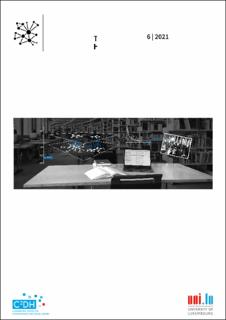| dc.contributor.author | Brughmans, Tom | |
| dc.contributor.author | Bobou, Olympia | |
| dc.contributor.author | Kristensen, Nathalia B. | |
| dc.contributor.author | Thomsen, Rikke R. | |
| dc.contributor.author | Jensen, Jesper V. | |
| dc.contributor.author | Seland, Eivind Heldaas | |
| dc.contributor.author | Raja, Rubina | |
| dc.date.accessioned | 2022-04-21T09:27:32Z | |
| dc.date.available | 2022-04-21T09:27:32Z | |
| dc.date.created | 2022-02-10T11:11:35Z | |
| dc.date.issued | 2021 | |
| dc.identifier.issn | 2535-8863 | |
| dc.identifier.uri | https://hdl.handle.net/11250/2991889 | |
| dc.description.abstract | In this proof-of-concept study we investigate the potential and chal-lenges of a formal network approach for the examination of 1st to 3rd century CE kinship networks in ancient Palmyra (in present-day Syria). The recent availabil-ity of a large, digitised archaeological dataset allows for a thorough reassessment of previously studied genealogies. By applying network and genealogical formal methods to these for the first time we can re-evaluate the genealogical complete-ness and gender bias in our sources, and scientifically explore the tendency for in-termarriage within an extended Palmyrene family.We combine archaeological information from funerary portraits in the exhaus-tive database created by the Palmyra Portrait Project with textual sources from fu-nerary and public inscriptions, and critically evaluate the differences and limits of these sources for genealogical studies. Applying formal network and genealog-ical techniques to these datasets, as well as comparing five different case studies, allows us to draw attention to four key points: (1) our sources confirm a high de-gree of genealogical incompleteness and gender bias, which was already known from studies of Palmyrene society; (2) to evaluate whether the relinking index can enhance debates on endogamy and exogamy practices in Palmyra; (3) funer-ary and public inscriptions are highly complementary and reveal different gene-alogical structures; and (4) to assess the assumptions behind creating uncertain relationships in funerary cases and their effects on our results. | en_US |
| dc.language.iso | eng | en_US |
| dc.publisher | Université du Luxembourg | en_US |
| dc.rights | Attribution-NoDerivatives 4.0 Internasjonal | * |
| dc.rights.uri | http://creativecommons.org/licenses/by-nd/4.0/deed.no | * |
| dc.subject | Sosiale nettverk | en_US |
| dc.subject | Social Networks | en_US |
| dc.title | A kinship network analysis of Palmyrene genealogies | en_US |
| dc.type | Journal article | en_US |
| dc.type | Peer reviewed | en_US |
| dc.description.version | publishedVersion | en_US |
| dc.rights.holder | Copyright 2021 the authors | en_US |
| cristin.ispublished | true | |
| cristin.fulltext | original | |
| cristin.qualitycode | 1 | |
| dc.identifier.doi | 10.25517/jhnr.v6i1.65 | |
| dc.identifier.cristin | 1999883 | |
| dc.source.journal | Journal of Historical Network Research (JHNR) | en_US |
| dc.source.pagenumber | 41-84 | en_US |
| dc.subject.nsi | VDP::Oldtidens historie: 080 | en_US |
| dc.subject.nsi | VDP::Ancient history: 080 | en_US |
| dc.identifier.citation | Journal of Historical Network Research (JHNR). 2021, 6 (1), 41-84. | en_US |
| dc.source.volume | 6 | en_US |
| dc.source.issue | 1 | en_US |

